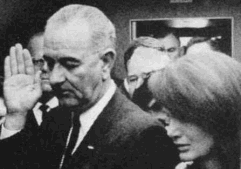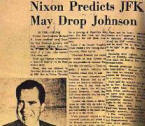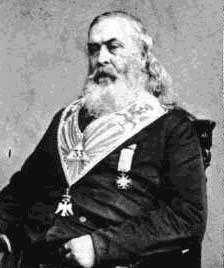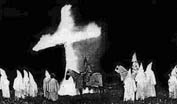|
Excerpt:
The Scottish Rite, the KKK and the ADL
Evidence that Pike was Chief Judiciary Officer of the KKK
THE EVIDENCE ON GENERAL ALBERT PIKE
by John Covici, January 19, 1993
In Response to the Scottish Rite/ADL Desperate Defense of The KKK's National Monument.
The
city councils of Birmingham and Tuskegee, Alabama; Austin, Texas; Newark,
New Jersey; Buffalo, New York; and New Orleans, Louisiana, have all called
for the removal of the statue of Ku Klux Klan founder Albert Pike from Judiciary
Square in Washington, D.C. Meanwhile, the Council of the District of Columbia,
considering whether to pass a resolution similar to those passed in the
other U.S. cities, has been warned by the Scottish Rite of Freemasonry and
the Anti-Defamation League of B'nai B'rith not to move to take down the
KKK monument. Albert Pike, national KKK chief judiciary officer and Grand
Dragon of the Arkansas Klan after the Civil War, is buried in a crypt at
the Headquarters Temple of the Scottish Rite, Southern Jurisdiction, at
16th and S Streets, Washington. Pike was Grand Commander of that masonic
group when he and his confederate clique organized the KKK.
|
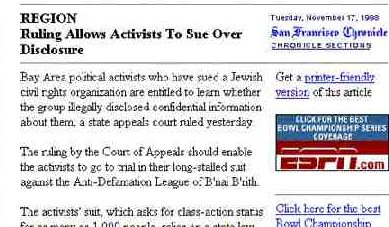
The ADL Blacklisting of Anti-Apartheid Activists
November 17, 1998: note the peculiar coverage of the same story. The story carried by the San Francisco Chronicle reads like an ADL press release. It makes no mention of the most critical aspect of the story-- the identity of the plaintiffs-- Pro-Palestinian and
anti-apartheid activists. For example, they note the plaintiffs are "Bay Area activists". But which ones? Environmental activists? Animal rights activists? Religious activists? Compare this to the AP release beolw.

Also ignored by the Chronicle are the key charges-- that the ADL used state records, including drivers licenses and Social Security numbers, to ruin the careers of anti-apartheid activists by dissemminating this confidential information to hostile parties. Why the harrassment and blacklisting of anti-apartheid activists from, of all things,
a civil rights organization?
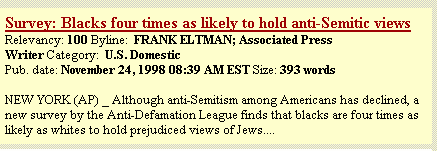 |
|
As if Blacks Built the Nazi Death Camps...
You'll notice this survey
above is intended to suggest blacks are four times more prone to racism
than any other demographic group. The implication of such defamatory
and unscientific studies are serious. This is an obvious attempt to
polarize Americans, particularly the Jewish community, against the African-American.
The Anti-Defamation League, created by the Bínai Bírith, has anything but
an untainted past when it comes to racism. According to author
Anton
Chaitkin: |
|
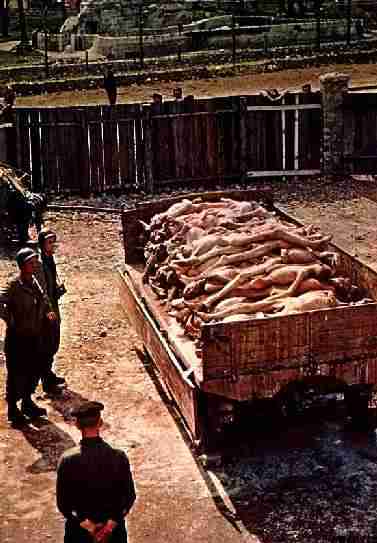
"The Independent Order of Bínai Bírith formed in 1843 as a Jewish community sub-project in the restoration of Masonry by the Scottish Rite and the British foreign office. Though most of its lodges were in the North, Bínai Bírith was openly pro-Confederate. Though it claimed to be neutral in the war, many of the Orderís Northern spokesmen were stridently pro-slavery. Bínai Bírithís post-Civil War leaders were pro-Confederate operatives, including later president Simon Wolf, who had been arrested by the War Department in Washington, D.C. as the lawyer for a Confederate spy ring.
"Rabbi Isaac Wise established Bínai Bírithís center for the "liberalizing" of Judaism in Cincinnati, Ohio-coinciding with Cincinnatiís other great Scottish Rite scheme, the launching of the Knights of the Golden Circle. Wise was officially neutral in the Civil War. Core leaders of the Bínai Bírith from then on have been Scottish Rite Masons. The political establishment associated with the Order has always had its headquarters in London...
"In the 1930s, Cyrus Adler, president of the American Jewish Committee, coordinated with the familyís Bínai Bírith, and the familyís {New York Times}, to crush all U.S. political action against Adolf Hitler in Germany. The Bínai Bírith was the one Jewish organization that Hitler deliberately {left open }and functioning under Nazi rule from 1933 on. In 1939, Britain made a dramatic change in its policy toward Hitler-after teaching Hitler his race theories, after forcefully backing his takeover of Germany, after financing and equipping his armies, Britain now changed publicly to opposing Hitler. Only at that point, in 1939, about a year after Hitler finally closed Bínai Bírithís Nazi-authorized German operations, Bínai Bírith decided to "approve" an international boycott against the Nazi regime....
"Bínai Bírithís Anti-Defamation League recently opened a vicious campaign to label American black leaders as anti-Semites, aiming at a racial conflict, and stomping on the memory of the young Jews who fought for civil rights in the 1960s. It is essential that the religious, national, and historical character of this racialism be precisely understood." It is apparent, judging by
the misleading and divisive surveys like the aforementioned propaganda;
that the ADL's campaign to label black American leaders as anti-Semites
has now expanded, and now aimed at labeling all blacks as anti-Semites.
Actually, it's not just blacks. Anyone that doesn't agree with the ADL,
or raises challenging and legitimate questions about their history, is invariably
labeled an anti-Semite. |
|
Why? Why has the Anti-Defamation League (ADL), a self-proclaimed "anti-bigotry'' lobby, acted to save the KKK's national monument? For starters, the ADL is officially subordinate to the B'nai B'rith, a pro-slavery masonic secret society formed under Scottish Rite control in the 1840s. The ADL, the Scottish Rite, and the Klan appeared openly together in the early 20th century as elements of the "British party" within American political life. In shameful national public statements and private actions, B'nai B'rith and the ADL denounced and viciously sabotaged all 1930s anti-Hitler protests by Jews.
From its inception, the ADL has fronted for organized crime figures including Meyer Lansky. The Scottish Rite and the ADL, in their telephone calls and visits to Washington, D.C. Council members, say that "there is no evidence that Pike was a member of the KKK"; or, that "there is no credible evidence of Pike's role in the Klan"; or, that "we can find no evidence" of such a role. As a fall-back, the ADL has also said that "there is no real evidence of Pike's role in the Klan; and even if there is such evidence, the issue is not important."' In the recent voluminous reporting on the subject of the Pike statue, news media have often quoted Scottish Rite representative Walter Lee Brown with variations of these defenses of Pike. In an October interview with the author, Brown said that he did not care what any historian has ever written about Pike. In his view, all evidence of Pike's evil acts put forward in the 20th century "is simply repeating slanders that were used against Pike when he was alive." Brown, who is writing an official biography of Pike for the Scottish Rite, contended that no condemnation of leaders of the post-Civil War Ku Klux Klan can be legitimate, because of the lack of documentary evidence against them.
This applies as well to the notorious KKK Grand Wizard, slave-trade millionaire and wartime racial murderer Nathan Bedford Forrest. "General Forrest did not actually admit that he was in the Klan," Brown explained. "So, where is your proof that he or anyone else actually ran the Klan?"
How Pike's Role Was Revealed
In considering the evidence of Albert Pike's KKK career, one must keep in perspective the mode of operation and legal status of the perpetrators in question. The KKK of the 1860s-1870s was a secret, terroristic society whose disguised members carried out thousands of murders, tortures, arson of schools and churches. The United States government sent troops into the southern states to put down Klan terrorism. One should not expect the KKK to have published membership and officers lists, to accommodate prosecution and suppression. Confederate General Albert Pike's KKK career has been widely known among historians, southerners, and federal government officials since about 1905, four years after the Pike memorial statue was dedicated. It was in 1905 that the Neale Publishing Company, New York and Washington, published Ku Klux Klan: Its Origin, Growth and Disbandment, written and edited by Walter L. Fleming, incorporating earlier published material by J.C. Lester and D.L. Wilson. Historian Walter Fleming's introduction to this 1905 book explains that he has been given "information in regard to Ku Klux Klan, by many former members of the order, and by their friends and relatives." Dr. Fleming states that "General Albert Pike, who stood high in the Masonic order, was the chief judicial officer of the Klan." On a page of illustrations of important founders of the KKK, Dr. Fleming places General Pike's portrait in the center, makes it larger than the six others on the page, and repeats this information as a caption: "General Albert Pike, chief judicial officer". Dr. Fleming attaches as an appendix to his book, a KKK "prescript" or secret constitution which had then recently been discovered. This document sets forth the regulations of the Klan's "judiciary"' department, over which Albert Pike ruled. This is the internal disciplinary or counterintelligence department. It also corresponds to Pike and the Klan's influence over the regular court system and the legal profession in the post-civil War southern states.
As the boss of all the southern secret societies and simultaneously president of the Tennessee Bar Association, Pike was the grand strategist of Klan "justice." It is to be stressed that Walter Fleming's book was not a slander or hatchet job against Albert Pike. Though it revealed much important data for the first time, it placed the KKK and Pike in the most favorable possible light. The book was a hit among diehard Confederates and Anglo-Saxon "race patriots," and it launched Fleming's career as the dean of southern historians. Fleming became the leading apologist for the KKK, and was the father of the modern historical line that Reconstruction was a corrupt oppression of the South. In September 1903, Fleming had written in the Journal of the Southern History Association: "The very need for such an organization in the disordered conditions of the time caused the Dens [KKK local units] to begin to exercise the duties of a police patrol for regulating the conduct of thieving and impudent negroes and similar "loyal' whites...." Dr. Fleming's biases have not hurt his reputation with established authorities. The National Cyclopedia of American Biography calls his 1905 Ku Klux Klan history "an authoritative account of that organization." The Dictionary of American Biography states bluntly: "Fleming covered the Civil War and Reconstruction in the South more fully than any other man. His works are characterized by ... scholarly objective. A Southerner, Fleming wrote of the sectional conflict with Southern sympathies yet he was more objective than most Southerners of his generation. The historiography of the Civil War and Reconstruction owes much to his indefatigable research, his breadth of scholarship, and power of interpretation." Basing his career on his defense of Pike's KKK, Fleming became dean of arts and sciences at Vanderbilt University in Nashville, Tennessee.
Pike's Tennessee Klan Command
It was in Nashville that Albert Pike and other Confederate generals met in 1867 to form a southern states-wide terrorist KKK, expanding the little project they had started two years before in Pulaski, Tenn. The organization he formed in Nashville designated Pike its chief judiciary officer, and its Grand Dragon for Arkansas. As owner-publisher of the Memphis, Tennessee, Daily Appeal, Albert Pike wrote in an editorial on April 16, 1868: "With negroes for witnesses and jurors, the administration of justice becomes a blasphemous mockery. A Loyal League of negroes can cause any white man to be arrested, and can prove any charges it chooses to have made against him. ...The disenfranchised people of the South ... can find no protection for property, liberty or life, except in secret association.... We would unite every white man in the South, who is opposed to negro suffrage, into one great Order of Southern Brotherhood, with an organization complete, active, vigorous, in which a few should execute the concentrated will of all, and whose very existence should be concealed from all but its members." (A copy of that issue of Pike's paper may be viewed at the Library of Congress, as may the books mentioned in this article.) But it was as the Sovereign Grand Commander of the Scottish Rite, and the recognized boss of the southern white masonic order, that Pike exercised the great clandestine power that welded the KKK together. Dr. Walter Fleming designates Confederate Major James R. Crowe as the pre-eminent source for his 1905 KKK History, and describes Crowe as one of the original KKK founders in Pulaski. Fleming says that Major Crowe "held high rank in the Masonic order." In his honor roll of "well-known members of the Klan," Dr. Fleming places "General John C. Brown, of Pulaski, Tennessee" and "Colonel Joseph Fussell, of Columbia, Tennessee."
General Brown and Colonel Fussell, like Major Crowe, are identifiable as soldiers of Albert Pike's masonic order. General Brown had been a master mason in the Pulaski lodge for 15 years when the KKK was formed there, and became grand master of Tennessee Masons and governor of Tennessee during the Klan's era of power. Colonel Fussell was commandant of Tennessee's masonic Knights Templar during the Klan rule. The preceding masonic information is taken from Tennessee Templars: A Register of Names with Biographical Sketches of the Knights Templar of Tennessee by James D. Richardson. This James D. Richardson was himself the Commandant of Knights Templar and Grand Master of Masons in Tennessee, and was speaker of the Tennessee House of Representatives during the era of the Klan power. This same James D. Richardson was Albert Pike's successor as commander of the southern Scottish Rite masons. It was this same Richardson who ordered the Pike statue to be erected in Washington, D.C. It was Richardson who, as a U.S. congressman from Tennessee, introduced into the U.S. House of Representatives the infamous 1898 resolution: It called for the federal government to provide federal land to Richardson's masonic organization, on which to put up their statue honoring the master strategist of KKK terror.
| The
Fort Pillow Massacre |
|
 |
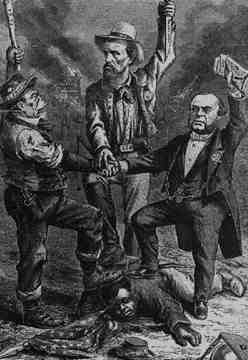 |
|
Nathan Bedford Forrest, leading a Confederate force, also distinguished himself as a war criminal at Fort Pillow, Tennessee; with the April 12th, 1864 massacre of over 300 Union troops who had laid down their arms in surrender as portrayed in this contemporary illustration. (Frank and Marie-Therese Wood Print Collections, Alexandria, VA) |
An 1868 Thomas Nast cartoon shows Forrest, center with a medal of "honor" marked Fort Pillow.
(Harper's Weekly, Sept.5, 1868/New York Public Library, New York City) |
|
|
Strange
Bedfellows
Another instance in which the ADL defended the views of the Klan and Aryan Nation, in spite of neo-Nazi leader Richard Butler's slander of the Jews in this article by attacking the alleged "Jewish educational system" which Prop. 209 was meant to abolish by destroying affirmative action. Other vocal proponents of this measure included David Duke, a former leader in the KKK who traveled all the way to California to press for the cause. (click photo for full size)
|
|
The KKK on Parade
Susan Lawrence Davis's 1924 Authentic History, Ku Klux Klan, 1865-1877, repeats the pattern Fleming created in 1905, revealing Pike's KKK role but treating him and the Klan sympathetically. The Davis book was written to celebrate the new, 20th-century KKK, which was just then staging full-dress mass marches in Washington and northern cities such as Detroit. In her chapter on General Pike's leadership of the Klan, Miss Davis applauds Pike's clever stewardship of the KKK secret organization. She reproduces in her KKK history an oil portrait of Albert Pike given to her for the KKK book by Pike's son. The same is true of other book-length histories of the Klan and numerous published biographies of Albert Pike: Pike's role as Klan leader or KKK boss of Arkansas is discussed, but treated as if KKK terrorist murder of African-Americans was "regrettable" but "only natural" and "understandable." In his book, The Tragic Era, Claude Bowers describes the KKK as patriotic southerners defending their way of life from out-of-control blacks and northerners. Bowers, who served many years as the U.S. ambassador to Spain and to Chile, described Albert Pike as one of the handful of distinguished, respectable founders of the KKK and the Klan's leader in Arkansas.
Bowers wrote that much of the KKK's alleged violence was actually perpetrated by Negroes disguised in Klan robes to wreak vengeance on other Negroes! Rather than quake in fear when the white southern masons or the ADL puts the muscle on, a citizen or his political representative ought to put this question to General Pike's defenders: "Do you say that Professor Fleming, Miss Davis, Mr. Bowers, and all the other pro-Confederate historians were liars when they wrote of Pike's marvelous deeds as KKK founder and leader?" They want to have it both ways: first to issue propaganda justifying Klan terrorism as the work of "respectable'' men like Pike; later, when their hero is under attack, to claim that their own propaganda slanders their man!
John Covici
|
